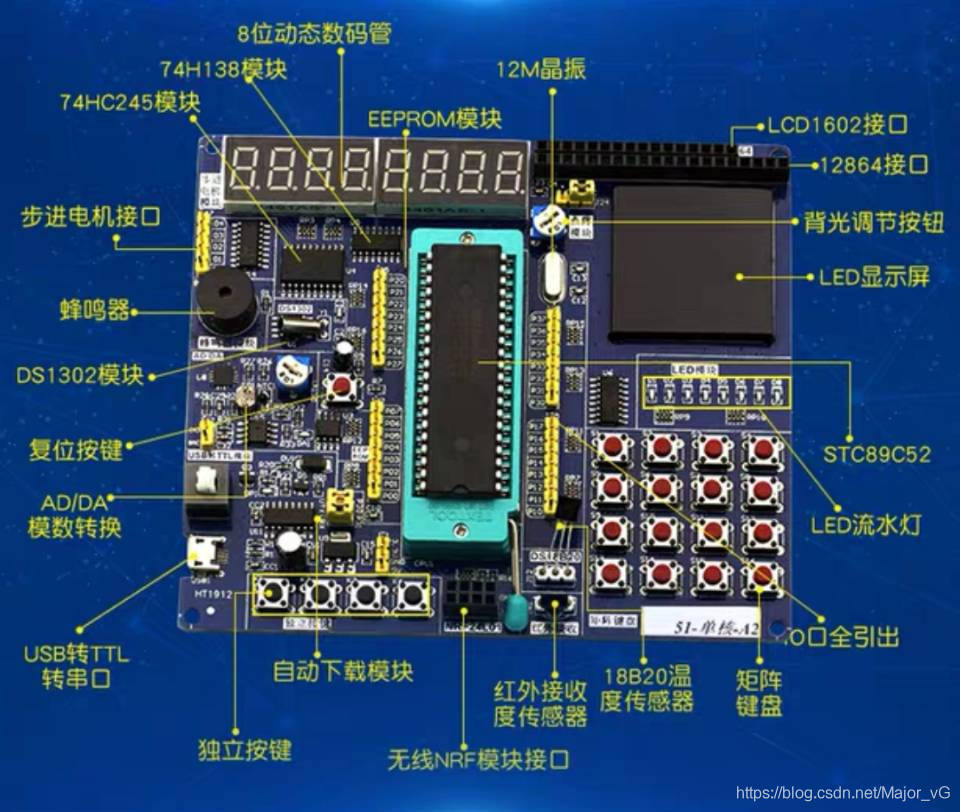
?51开发板实物图
数码管用于显示数字
 ???????
??????? 
?138译码器作用:工作原理如下:当一个选通端(G1)为高电平,另两个选通端(/(G2A)和/(G2B))为低电平时,可将地址端(A、B、C)的二进制编码在一个对应的输出端以低电平译出(详细作用百度^_^)
数码管的重点在于位选与段选
?矩阵按键作为计算器键盘
 ( “ ~ ” 是清零 )
( “ ~ ” 是清零 )
0??????? 1??????? 2??????? 3
4??????? 5??????? 6??????? 7
8??????? 9??????? +??????? -
/??????? *??????? ~???????? =
?
/*************************
矩 阵 按 键
0 1 2 3
4 5 6 7
8 9 + -
/ * ~ =
*************************/
#include "reg51.h"
typedef unsigned char u8; //对数据类型进行声明定义
typedef unsigned int u16;
sbit A0=P2^2; //138译码器数码管位选
sbit A1=P2^3;
sbit A2=P2^4;
#define GPIO_KEY P1
#define GPIO_DIG P0
u16 KeyValue; //用来存放读取到的键值
u16 keyflag,i; //用来判断按下的数字还是运算符或清空键
u8 code smgduan[]= {0x3f,0x06,0x5b,0x4f,0x66,0x6d,0x7d,0x07,
0x7f,0x6f,0x77,0x7c,0x39,0x5e,0x79,0x71,0x40}; //共阳极 显示0~F、负号‘-’
u16 tude[8]= {0}; //用来存放每一位数码管数字的数组
void delay(u16 i)//延时函数
{
while(i--);
}
void display() //扫描显示动态数码管
{
A0=0; A1=0; A2=0; GPIO_DIG=smgduan[tude[0]]; delay(50); GPIO_DIG=0x00; //消隐
A0=1; A1=0; A2=0; GPIO_DIG=smgduan[tude[1]]; delay(50); GPIO_DIG=0x00;
A0=0; A1=1; A2=0; GPIO_DIG=smgduan[tude[2]]; delay(50); GPIO_DIG=0x00;
A0=1; A1=1; A2=0; GPIO_DIG=smgduan[tude[3]]; delay(50); GPIO_DIG=0x00;
A0=0; A1=0; A2=1; GPIO_DIG=smgduan[tude[4]]; delay(50); GPIO_DIG=0x00;
A0=1; A1=0; A2=1; GPIO_DIG=smgduan[tude[5]]; delay(50); GPIO_DIG=0x00;
A0=0; A1=1; A2=1; GPIO_DIG=smgduan[tude[6]]; delay(50); GPIO_DIG=0x00;
A0=1; A1=1; A2=1; GPIO_DIG=smgduan[tude[7]]; delay(50); GPIO_DIG=0x00;
}
void KeyDown()//检测有按键按下并读取键值
{
u16 a=0;
GPIO_KEY=0x0f;
if(GPIO_KEY!=0x0f)//读取按键是否按下
{
delay(1000);//延时10ms进行消抖
if(GPIO_KEY!=0x0f)//再次检测键盘是否按下
{
/** 行列扫描法**/
//测试列
GPIO_KEY=0x0f;
switch(GPIO_KEY)
{
case(0X07): KeyValue=0; break;
case(0X0b): KeyValue=1; break;
case(0X0d): KeyValue=2; break;
case(0X0e): KeyValue=3; break;
}
//测试行
GPIO_KEY=0xf0;
switch(GPIO_KEY)
{
case(0X70): KeyValue=KeyValue; break;
case(0Xb0): KeyValue=KeyValue+4; break;
case(0Xd0): KeyValue=KeyValue+8; break;
case(0Xe0): KeyValue=KeyValue+12; break;
}
if(KeyValue==0 || KeyValue==1 || KeyValue==2 || KeyValue==3 || KeyValue==4 || KeyValue==5 || KeyValue==6 || KeyValue==7 || KeyValue==8 || KeyValue==9)
{
keyflag=1;
}
while((a<50)&&(GPIO_KEY!=0xf0)) //检测按键松手检测
{
delay(1000);
a++;
}
}
}
}
void main()
{
u16 a=0,b=0,c=0;
while(1)
{
display(); /* 第一个数字输入*/
KeyDown();
if(keyflag==1)
{
for(i=7; i>0; i--) //输入一位,数字向左移动一位
{
tude[i]=tude[i-1];
}
tude[0]=KeyValue;
keyflag=0;
}
/**** 对数码管清零 ****/
else if(KeyValue==14)
{
for(i=0; i<8; i++)
tude[i]=0;
display();
}
/**** 加法运算 ****/
else if(KeyValue==10)
{
a=tude[0]+tude[1]*10+tude[2]*100+tude[3]*1000+tude[4]*10000+tude[5]*100000+tude[6]*1000000+tude[7]*10000000; //计算a的值
for(i=0; i<8; i++)
tude[i]=0;
while(1) //输入第二个数
{
display();
KeyDown();
if(KeyValue==15) break;//当读到等于号,既,KeyValue=15时,停止输入
if(keyflag==1)
{
for(i=7; i>0; i--)
{
tude[i]=tude[i-1];
}
tude[0]=KeyValue;
keyflag=0;
}
}
b=tude[0]+tude[1]*10+tude[2]*100+tude[3]*1000+tude[4]*10000+tude[5]*100000+tude[6]*1000000+tude[7]*10000000; //计算b的值
c=a+b;
tude[0]=c%10; //计算C的各个位的数字
tude[1]=c/10%10;
tude[2]=c/100%10;
tude[3]=c/1000%10;
tude[4]=c/10000%10;
tude[5]=c/100000%10;
tude[6]=c/1000000%10;
tude[7]=c/10000000%10;
display();
}
/**** 减法运算 ****/
else if(KeyValue==11)
{
a=tude[0]+tude[1]*10+tude[2]*100+tude[3]*1000+tude[4]*10000+tude[5]*100000+tude[6]*1000000+tude[7]*10000000;
for(i=0; i<8; i++)
tude[i]=0;
while(1)
{
//输入第二个数
display();
KeyDown();
if(KeyValue==15) break;
if(keyflag==1)
{
for(i=7; i>0; i--)
{
tude[i]=tude[i-1];
}
tude[0]=KeyValue;
keyflag=0;
}
}
b=tude[0]+tude[1]*10+tude[2]*100+tude[3]*1000+tude[4]*10000+tude[5]*100000+tude[6]*1000000+tude[7]*10000000; //计算b的值
if(a>=b)
{
c=a-b;
tude[0]=c%10; //计算C的各个位的数字
tude[1]=c/10%10;
tude[2]=c/100%10;
tude[3]=c/1000%10;
tude[4]=c/10000%10;
tude[5]=c/100000%10;
tude[6]=c/1000000%10;
tude[7]=c/10000000%10;
}
if(a<b)//相减得负数
{
u16 e=0;//用于判断负号的位置
c=b-a;
tude[0]=c%10; //计算C的各个位的数字
tude[1]=c/10%10;
if(tude[1]==0)
{
tude[1]=16; //
e=1;
}
tude[2]=c/100%10;
if(tude[2]==0 && e==0)
{
tude[2]=16;
e=1;
}
tude[3]=c/1000%10;
if(tude[3]==0 && e==0)
{
tude[3]=16;
e=1;
}
tude[4]=c/10000%10;
if(tude[4]==0 && e==0)
{
tude[4]=16;
e=1;
}
tude[5]=c/100000%10;
if(tude[5]==0 && e==0)
{
tude[5]=16;
e=1;
}
tude[6]=c/1000000%10;
if(tude[6]==0 && e==0)
{
tude[6]=16;
e=1;
}
tude[7]=c/10000000%10;
if(tude[7]==0 && e==0)
{
tude[7]=16;
e=1;
}
}
display();
}
/**** 除法运算 ****/
else if(KeyValue==12)
{
a=tude[0]+tude[1]*10+tude[2]*100+tude[3]*1000+tude[4]*10000+tude[5]*100000+tude[6]*1000000+tude[7]*10000000;
for(i=0; i<8; i++)
tude[i]=0;
while(1)
{
//输入第二个数
display();
KeyDown();
if(KeyValue==15) break;
if(keyflag==1)
{
for(i=7; i>0; i--)
{
tude[i]=tude[i-1];
}
tude[0]=KeyValue;
keyflag=0;
}
}
b=tude[0]+tude[1]*10+tude[2]*100+tude[3]*1000+tude[4]*10000+tude[5]*100000+tude[6]*1000000+tude[7]*10000000; //计算b的值
c=a/b;
tude[0]=c%10; //计算C的各个位的数字
tude[1]=c/10%10;
tude[2]=c/100%10;
tude[3]=c/1000%10;
tude[4]=c/10000%10;
tude[5]=c/100000%10;
tude[6]=c/1000000%10;
tude[7]=c/10000000%10;
display();
}
/**** 乘法运算 ****/
else if(KeyValue==13)
{
a=tude[0]+tude[1]*10+tude[2]*100+tude[3]*1000+tude[4]*10000+tude[5]*100000+tude[6]*1000000+tude[7]*10000000;
for(i=0; i<8; i++)
tude[i]=0;
while(1) //输入第二个数
{
display();
KeyDown();
if(KeyValue==15) break;
if(keyflag==1)
{
for(i=7; i>0; i--)
{
tude[i]=tude[i-1];
}
tude[0]=KeyValue;
keyflag=0;
}
}
b=tude[0]+tude[1]*10+tude[2]*100+tude[3]*1000+tude[4]*10000+tude[5]*100000+tude[6]*1000000+tude[7]*10000000; //计算b的值
c=a*b;
tude[0]=c%10; //计算C的各个位的数字
tude[1]=c/10%10;
tude[2]=c/100%10;
tude[3]=c/1000%10;
tude[4]=c/10000%10;
tude[5]=c/100000%10;
tude[6]=c/1000000%10;
tude[7]=c/10000000%10;
display(); //显示最终结果
}
}
}